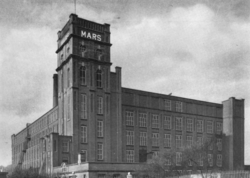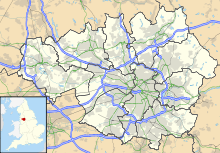- Mars Mill, Castleton
-
Coordinates: 53°35′49″N 2°11′10″W / 53.5969°N -2.1860°E
Mars 
Mars millCotton Spinning (Fine Egyptianb) Location Castleton Serving canal Rochdale Canal Serving Railway Lancashire and Yorkshire Railway Further ownership Lancashire Cotton Corporation (1930s) Courtaulds () Coordinates 53°35′49″N 2°11′10″W / 53.5969°N -2.1860°E Demolished 1960s Power Date 1908 Construction Firm Urmson & Thompson Engine Type cross compound Valve Gear Corliss valves rpm 67rpm Diameter of Flywheel 24ft No, of Ropes. 36ropes Boiler configuration Pressure 160psi Equipment Cotton count 76 + Mule Frames 115,630 mule spindles(1919) References [1] Mars Mill is a former cotton spinning mill in Castleton, Rochdale, Greater Manchester. Castleton joined the Borough of Rochdale in 1899. Queensway, Castleton was a hub of cotton mills Mars, Marland, and Castleton Mill were a group of three. It was taken over by the Lancashire Cotton Corporation in the 1930s and passed to Courtaulds in 1964 and demolished in the 1990s; Marland survived until 2004.
Contents
Location
Rochdale is a large market town in Greater Manchester, England.[2] It lies amongst the foothills of the Pennines on the River Roch, 5.3 miles (8.5 km) north-northwest of Oldham, and 9.8 miles (15.8 km) north-northeast of the city of Manchester. Rochdale is surrounded by several smaller settlements which together form the Metropolitan Borough of Rochdale.Castleton lies to the south west, just north of Chadderton, it became part of Rochdale in 1899.
Castleton is served by the Rochdale Canal which officially opened in 1804. This provides a broad canal link across the Pennines and consequently became an important transport corridor. Within in Greater Manchester, the canal started at the Bridgewater Canal, linked with Ashton Canal and passed through Ancoats, Droylsden, Moston, Middleton and Chadderton before passing Castleton and to the south of Rochdale towards Todmorden. The canal carried coal and cotton to the mills, and the completed yarn to the weaving sheds. In 1890 the canal company had 2,000 barges and traffic reached 700,000 tons/year, the equivalent of 50 barges a day,[3] despite competition from the Manchester and Leeds Railway.
The rail service provided by the Manchester and Leeds Railway from 1839 had important goods yards at Castleton. It was amalgamated into the Lancashire and Yorkshire Railway in 1847; lines ran to Bury, Burnley, Oldham, Manchester and Leeds.
History
It was a boomtown of the Industrial Revolution, and amongst the first ever industrialised towns.[4] The Rochdale Canal—one of the major navigable broad canals of the United Kingdom—was a highway of commerce during this time used for the haulage of cotton, wool, coal to and from the area.[4] In 1882, Rochdale the home of industrial co-operatives, embraced the joint stock limited company and new mills were financed and built.[5] Its ownership model was slightly different from that of Oldham, and more shares remained in the hands of the operatives. The canal created jobs for hundreds of local residents, as it enabled the construction of several cotton mills. With the mills came the need for engineering and from 1892, Castleton was the home of Tweedales and Smalley who manufactured looms and textile machinery. Their 14-acre (5.7 ha) Globe Works factory no longer exists, now part of the Woolworth's site.
The Manchester and Leeds Railway Company (later the Lancashire and Yorkshire Railway) arrived in Castleton in 1839.
Mars Mill was an Edwardian mill built in the construction boom around 1906, by Mars Mill Limited. It was built to spin the finest Egyptian cotton.The industry peaked in 1912 when it produced 8 billion yards of cloth. The Great War of 1914–18 halted the supply of raw cotton, and the British government encouraged its colonies to build mills to spin and weave cotton. The war over, Lancashire never regained its markets. In 1913 the directors were adding an extra storey to the mill, and did not pay a dividend but did made a small profit. In 1914, fine count mills were in difficulties and Mars Mill made a half year loss of £4,486.[6] By 1919 the independent mills were struggling. The shareholders agreed to a recommendation to sell the mill to Messrs. Cottam and Mellor, of Oldham, for £258,000; that is £12.15s for each of the 16,000 ordinary shares of £2.10s. and £1.2s 6d. for each of the £1 preference shares. A new company was floated. The Mars Mill (1920) Limited, was registered with a capital of £300,000 in £1 shares.
The Bank of England set up the Lancashire Cotton Corporation in 1929 to attempt to rationalise and save the industry.[7] Mars Mill, Castleton was one of 104 mills bought by the LCC, and one of the 53 mills that survived through to 1950, when it was spinning the finest Egyptian cotton, producing combed quality yarns from Ring and mule in the range of 74 to 120s.[1]. It was demolished in the 1990s. The adjacent Marland Mill stood until 2004.[8]
Architecture
Standard Edwardian-style mill with a simple water tower. Detached engine house laid out for a horizonal cross compound. It had four storeys; a fifth storey was added in 1913/14 to accommodate an additional 30,000 spindles.
Engine
Driven by a 1700 hp cross compound engine by Urmson & Thompson, 1908 similar to the one in Royton Ring Mill, Royton. Probably had a 24-foot flywheel running at 67 rpm with 36 ropes. The cylinders, 29"HP, 59"LP, had a 5 ft stroke. It had Corliss valves on both cylinders. The air pump was driven from LP tail rod with support guides on LP only.
Owners
- Mars Mill Limited (1906–19)
- Messrs. Cottam and Mellor, of Oldham (1919)
- Mars Mill (1920) Limited (1920–1930s)
- Lancashire Cotton Corporation (1930s–1964)
- Courtaulds (1964–)
b
See also
Lancashire cotton Architects 
Engine makers Daniel Adamson · Ashton Frost · Ashworth & Parker · Bateman & Sherratt · Boulton & Watt · Browett & Lindley · Buckley & Taylor · Carel · Earnshaw & Holt · Goodfellow · Fairbairn · W & J Galloway & Sons · B Goodfellow · Hick, Hargreaves & Co · Benjamin Hick and Sons · John Musgrave & Sons · J & W McNaught · Petrie of Rochdale · George Saxon · Scott & Hodgson · Urmson & Thompson · Yates of Blackburn · Yates & Thom · Whilans · J & E Wood · Woolstenhulmes & RyeMachinery makers Brooks & Doxey · Butterworth & Dickinson · Curtis, Parr & Walton · Dobson & Barlow · John Hetherington & Sons · Joseph Hibbert · Howard & Bullough · Geo. Hattersley · Asa Lees · Mather & Platt · Parr, Curtis & Madely · Platt Brothers · Taylor, Lang & Co · Textile Machinery Makers Ltd · Tweedales & Smalley- Oldham Limiteds · Fine Spinners and Doublers · Lancashire Cotton Corporation · Courtaulds · Bagley & WrightIndustrial processes Textile manufacturing · Cotton-spinning machinery · Friction Spinning · Magnetic ring spinning · Open end spinning · Ring spinning · Spinning frame · Spinning jenny · Spinning mule · Water frame · Roberts Loom · Lancashire LoomLists of mills LCC mills · Bolton · Bury · Cheshire · Derbyshire · Lancashire · Manchester · Oldham · Rochdale · Salford · Stockport · Tameside · WiganMuseums Bury Pilot Mill, Bury · Wilton Mill, Radcliffe
Bolton Lancashire Manchester and Salford Oldham Ace Mill, Hollinwood · Blackridings Mill, Oldham · Dawn Mill, Shaw · Fox Mill, Hollinwood · Hawk Mill, Shaw · Heron Mill, Hollinwood · Junction Mill, Middleton Junction · Kent Mill, Chadderton · Laurel Mill, Middleton Junction · Magnet Mill, Chadderton · Majestic Mill, Waterhead · Manor Mill, Chadderton · Newby Mill, Shaw · Orme Mill, Waterhead · Regent Mill, Failsworth · Royd Mill, Oldham · Royton Ring Mill, Royton · Rutland Mill, Shaw · Textile Mill, Chadderton · Trent Mill, ShawRochdale Stockport Elder Mill, Romiley · Kingston Mill, Stockport · Palmer Mills, Stockport · Vernon Mill, Stockport · Welkin Mill, Lower BredburyTameside Atlas Mill, Ashton-under-Lyne · Cedar Mill, Ashton-under-Lyne · Rock Mill, Ashton-under-Lyne · Saxon Mill, Droylsden · Stalybridge Mill, Stalybridge · Texas Mill, Ashton-under-Lyne · Tudor Mill, Ashton-under-Lyne · Waterside Mill, Ashton-under-LyneWigan West Yorkshire Foxsons Mill, Staincliffe · Mons Mill, TodmordenReferences
Notes
- ^ a b LCC 1951
- ^ Greater Manchester Gazetteer, Greater Manchester County Record Office, Places names - O to R, http://www.gmcro.co.uk/Guides/Gazeteer/gazzo2r.htm, retrieved 9 July 2007
- ^ New Moston History Society "Rochdale Canal". http://www.m-cr.net/nmhs/index.php?page=pages&menuid=12. Retrieved 2007-12-16.
- ^ a b . McNeil, R.; Nevell, M. (2000), A Guide to the Industrial Archaeology of Greater Manchester, Association for Industrial Archaeology, ISBN 0-9528930-3-7
- ^ Williams & Farnie 1992, p. 44
- ^ http://www.link4life.org/index.cfm?fuseaction=c.showPage&pageID=651
- ^ Dunkerley 2009
- ^ http://www.rochdaleobserver.co.uk/news/s/345/345578_memories_of_marland_fall_to_the_ground.html
Bibliography
- Dunkerley, Philip (2009). "Dunkerley-Tuson Family Website, The Regent Cotton Mill, Failsworth". http://dunkerley-tuson.co.uk/regentmill.aspx. Retrieved 2009-01-09.
- LCC (1951). The mills and organisation of the Lancashire Cotton Corporation Limited. Blackfriars House, Manchester: Lancashire Cotton Corporation Limited.
- Roberts, A S (1921), "Arthur Robert's Engine List", Arthur Roberts Black Book. (One guy from Barlick-Book Transcription), http://oneguyfrombarlick.co.uk/forum_topic.asp?TOPIC_ID=7926&FORUM_ID=99&CAT_ID=3&Forum_Title=Rare+Text+(Book+Transcriptions)&Topic_Title=ARTHUR+ROBERTS+ENGINE+LIST&whichpage=1&tmp=1#pid81483, retrieved 2009-01-11
External links
Categories:- Textile mills owned by the Lancashire Cotton Corporation
- Textile mills in Rochdale
- Castleton, Greater Manchester
Wikimedia Foundation. 2010.

